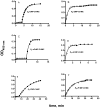Stereo-specific synthesis of analogs of nerve agents and their utilization for selection and characterization of paraoxonase (PON1) catalytic scavengers
- PMID: 20303930
- PMCID: PMC2912971
- DOI: 10.1016/j.cbi.2010.02.039
Stereo-specific synthesis of analogs of nerve agents and their utilization for selection and characterization of paraoxonase (PON1) catalytic scavengers
Abstract
Fluorogenic organophosphate inhibitors of acetylcholinesterase (AChE) homologous in structure to nerve agents provide useful probes for high throughput screening of mammalian paraoxonase (PON1) libraries generated by directed evolution of an engineered PON1 variant with wild-type like specificity (rePON1). Wt PON1 and rePON1 hydrolyze preferentially the less-toxic R(P) enantiomers of nerve agents and of their fluorogenic surrogates containing the fluorescent leaving group, 3-cyano-7-hydroxy-4-methylcoumarin (CHMC). To increase the sensitivity and reliability of the screening protocol so as to directly select rePON1 clones displaying stereo-preference towards the toxic S(P) enantiomer, and to determine accurately K(m) and k(cat) values for the individual isomers, two approaches were used to obtain the corresponding S(P) and R(P) isomers: (a) stereo-specific synthesis of the O-ethyl, O-n-propyl, and O-i-propyl analogs and (b) enzymic resolution of a racemic mixture of O-cyclohexyl methylphosphonylated CHMC. The configurational assignments of the S(P) and R(P) isomers, as well as their optical purity, were established by X-ray diffraction, reaction with sodium fluoride, hydrolysis by selected rePON1 variants, and inhibition of AChE. The S(P) configuration of the tested surrogates was established for the enantiomer with the more potent anti-AChE activity, with S(P)/R(P) inhibition ratios of 10-100, whereas the R(P) isomers of the O-ethyl and O-n-propyl were hydrolyzed by wt rePON1 about 600- and 70-fold faster, respectively, than the S(P) counterpart. Wt rePON1-induced R(P)/S(P) hydrolysis ratios for the O-cyclohexyl and O-i-propyl analogs are estimated to be >>1000. The various S(P) enantiomers of O-alkyl-methylphosphonyl esters of CHMC provide suitable ligands for screening rePON1 libraries, and can expedite identification of variants with enhanced catalytic proficiency towards the toxic nerve agents.
Copyright (c) 2010 Elsevier Ireland Ltd. All rights reserved.
Conflict of interest statement
Figures



References
-
- Ashani Y, Rothschild N, Segall Y, Levanon D, Raveh L. Prophylaxis against organophosphate poisoning by an enzyme hydrolyzing organophosphorus compounds in mice. Life Sci. 1991;49:367–374. - PubMed
-
- Raveh L, Segall Y, Leader H, Rothschild N, Levanon D, Ashani Y. Protection against tabun intoxication in mice by prophylaxis with an enzyme hydrolyzing organophosphate esters. Biochem Pharmacol. 1992;44:397–400. - PubMed
Publication types
MeSH terms
Substances
Grants and funding
LinkOut - more resources
Full Text Sources
Other Literature Sources
Medical
Miscellaneous

